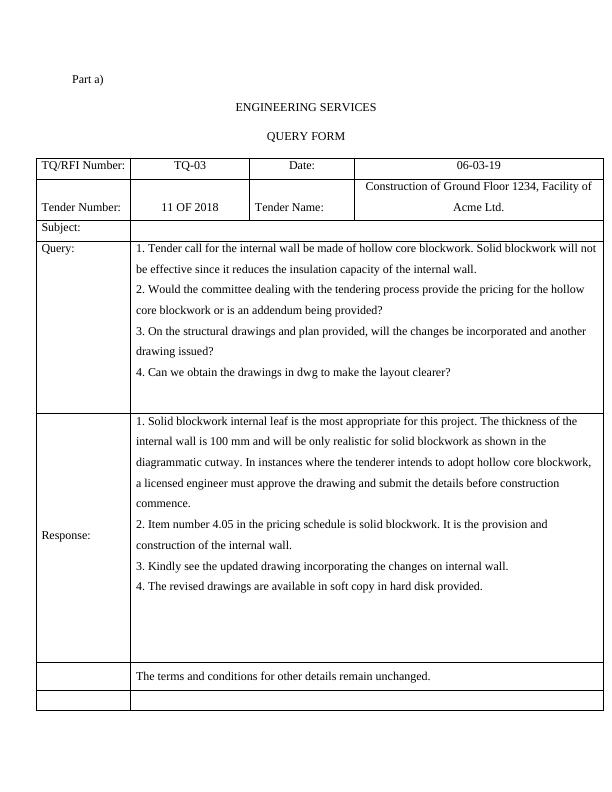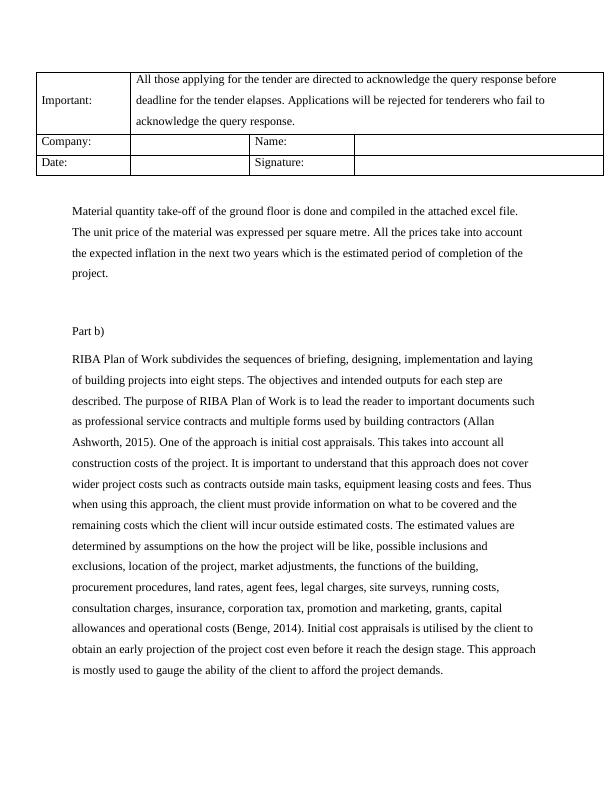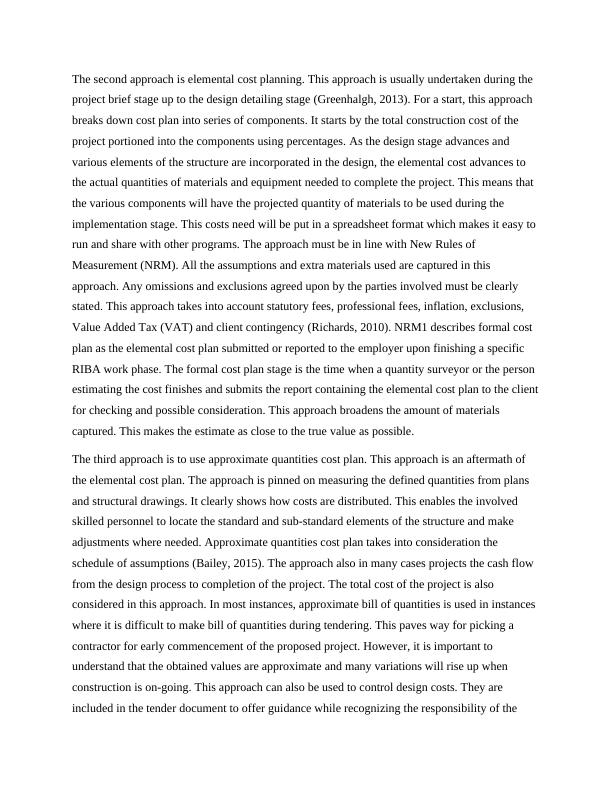Approaches to Cost Estimation in Construction Projects
Added on 2023-04-23
7 Pages2651 Words175 Views
Part a)
ENGINEERING SERVICES
QUERY FORM
TQ/RFI Number: TQ-03 Date: 06-03-19
Tender Number: 11 OF 2018 Tender Name:
Construction of Ground Floor 1234, Facility of
Acme Ltd.
Subject:
Query: 1. Tender call for the internal wall be made of hollow core blockwork. Solid blockwork will not
be effective since it reduces the insulation capacity of the internal wall.
2. Would the committee dealing with the tendering process provide the pricing for the hollow
core blockwork or is an addendum being provided?
3. On the structural drawings and plan provided, will the changes be incorporated and another
drawing issued?
4. Can we obtain the drawings in dwg to make the layout clearer?
Response:
1. Solid blockwork internal leaf is the most appropriate for this project. The thickness of the
internal wall is 100 mm and will be only realistic for solid blockwork as shown in the
diagrammatic cutway. In instances where the tenderer intends to adopt hollow core blockwork,
a licensed engineer must approve the drawing and submit the details before construction
commence.
2. Item number 4.05 in the pricing schedule is solid blockwork. It is the provision and
construction of the internal wall.
3. Kindly see the updated drawing incorporating the changes on internal wall.
4. The revised drawings are available in soft copy in hard disk provided.
The terms and conditions for other details remain unchanged.
ENGINEERING SERVICES
QUERY FORM
TQ/RFI Number: TQ-03 Date: 06-03-19
Tender Number: 11 OF 2018 Tender Name:
Construction of Ground Floor 1234, Facility of
Acme Ltd.
Subject:
Query: 1. Tender call for the internal wall be made of hollow core blockwork. Solid blockwork will not
be effective since it reduces the insulation capacity of the internal wall.
2. Would the committee dealing with the tendering process provide the pricing for the hollow
core blockwork or is an addendum being provided?
3. On the structural drawings and plan provided, will the changes be incorporated and another
drawing issued?
4. Can we obtain the drawings in dwg to make the layout clearer?
Response:
1. Solid blockwork internal leaf is the most appropriate for this project. The thickness of the
internal wall is 100 mm and will be only realistic for solid blockwork as shown in the
diagrammatic cutway. In instances where the tenderer intends to adopt hollow core blockwork,
a licensed engineer must approve the drawing and submit the details before construction
commence.
2. Item number 4.05 in the pricing schedule is solid blockwork. It is the provision and
construction of the internal wall.
3. Kindly see the updated drawing incorporating the changes on internal wall.
4. The revised drawings are available in soft copy in hard disk provided.
The terms and conditions for other details remain unchanged.

Important:
All those applying for the tender are directed to acknowledge the query response before
deadline for the tender elapses. Applications will be rejected for tenderers who fail to
acknowledge the query response.
Company: Name:
Date: Signature:
Material quantity take-off of the ground floor is done and compiled in the attached excel file.
The unit price of the material was expressed per square metre. All the prices take into account
the expected inflation in the next two years which is the estimated period of completion of the
project.
Part b)
RIBA Plan of Work subdivides the sequences of briefing, designing, implementation and laying
of building projects into eight steps. The objectives and intended outputs for each step are
described. The purpose of RIBA Plan of Work is to lead the reader to important documents such
as professional service contracts and multiple forms used by building contractors (Allan
Ashworth, 2015). One of the approach is initial cost appraisals. This takes into account all
construction costs of the project. It is important to understand that this approach does not cover
wider project costs such as contracts outside main tasks, equipment leasing costs and fees. Thus
when using this approach, the client must provide information on what to be covered and the
remaining costs which the client will incur outside estimated costs. The estimated values are
determined by assumptions on the how the project will be like, possible inclusions and
exclusions, location of the project, market adjustments, the functions of the building,
procurement procedures, land rates, agent fees, legal charges, site surveys, running costs,
consultation charges, insurance, corporation tax, promotion and marketing, grants, capital
allowances and operational costs (Benge, 2014). Initial cost appraisals is utilised by the client to
obtain an early projection of the project cost even before it reach the design stage. This approach
is mostly used to gauge the ability of the client to afford the project demands.
All those applying for the tender are directed to acknowledge the query response before
deadline for the tender elapses. Applications will be rejected for tenderers who fail to
acknowledge the query response.
Company: Name:
Date: Signature:
Material quantity take-off of the ground floor is done and compiled in the attached excel file.
The unit price of the material was expressed per square metre. All the prices take into account
the expected inflation in the next two years which is the estimated period of completion of the
project.
Part b)
RIBA Plan of Work subdivides the sequences of briefing, designing, implementation and laying
of building projects into eight steps. The objectives and intended outputs for each step are
described. The purpose of RIBA Plan of Work is to lead the reader to important documents such
as professional service contracts and multiple forms used by building contractors (Allan
Ashworth, 2015). One of the approach is initial cost appraisals. This takes into account all
construction costs of the project. It is important to understand that this approach does not cover
wider project costs such as contracts outside main tasks, equipment leasing costs and fees. Thus
when using this approach, the client must provide information on what to be covered and the
remaining costs which the client will incur outside estimated costs. The estimated values are
determined by assumptions on the how the project will be like, possible inclusions and
exclusions, location of the project, market adjustments, the functions of the building,
procurement procedures, land rates, agent fees, legal charges, site surveys, running costs,
consultation charges, insurance, corporation tax, promotion and marketing, grants, capital
allowances and operational costs (Benge, 2014). Initial cost appraisals is utilised by the client to
obtain an early projection of the project cost even before it reach the design stage. This approach
is mostly used to gauge the ability of the client to afford the project demands.

The second approach is elemental cost planning. This approach is usually undertaken during the
project brief stage up to the design detailing stage (Greenhalgh, 2013). For a start, this approach
breaks down cost plan into series of components. It starts by the total construction cost of the
project portioned into the components using percentages. As the design stage advances and
various elements of the structure are incorporated in the design, the elemental cost advances to
the actual quantities of materials and equipment needed to complete the project. This means that
the various components will have the projected quantity of materials to be used during the
implementation stage. This costs need will be put in a spreadsheet format which makes it easy to
run and share with other programs. The approach must be in line with New Rules of
Measurement (NRM). All the assumptions and extra materials used are captured in this
approach. Any omissions and exclusions agreed upon by the parties involved must be clearly
stated. This approach takes into account statutory fees, professional fees, inflation, exclusions,
Value Added Tax (VAT) and client contingency (Richards, 2010). NRM1 describes formal cost
plan as the elemental cost plan submitted or reported to the employer upon finishing a specific
RIBA work phase. The formal cost plan stage is the time when a quantity surveyor or the person
estimating the cost finishes and submits the report containing the elemental cost plan to the client
for checking and possible consideration. This approach broadens the amount of materials
captured. This makes the estimate as close to the true value as possible.
The third approach is to use approximate quantities cost plan. This approach is an aftermath of
the elemental cost plan. The approach is pinned on measuring the defined quantities from plans
and structural drawings. It clearly shows how costs are distributed. This enables the involved
skilled personnel to locate the standard and sub-standard elements of the structure and make
adjustments where needed. Approximate quantities cost plan takes into consideration the
schedule of assumptions (Bailey, 2015). The approach also in many cases projects the cash flow
from the design process to completion of the project. The total cost of the project is also
considered in this approach. In most instances, approximate bill of quantities is used in instances
where it is difficult to make bill of quantities during tendering. This paves way for picking a
contractor for early commencement of the proposed project. However, it is important to
understand that the obtained values are approximate and many variations will rise up when
construction is on-going. This approach can also be used to control design costs. They are
included in the tender document to offer guidance while recognizing the responsibility of the
project brief stage up to the design detailing stage (Greenhalgh, 2013). For a start, this approach
breaks down cost plan into series of components. It starts by the total construction cost of the
project portioned into the components using percentages. As the design stage advances and
various elements of the structure are incorporated in the design, the elemental cost advances to
the actual quantities of materials and equipment needed to complete the project. This means that
the various components will have the projected quantity of materials to be used during the
implementation stage. This costs need will be put in a spreadsheet format which makes it easy to
run and share with other programs. The approach must be in line with New Rules of
Measurement (NRM). All the assumptions and extra materials used are captured in this
approach. Any omissions and exclusions agreed upon by the parties involved must be clearly
stated. This approach takes into account statutory fees, professional fees, inflation, exclusions,
Value Added Tax (VAT) and client contingency (Richards, 2010). NRM1 describes formal cost
plan as the elemental cost plan submitted or reported to the employer upon finishing a specific
RIBA work phase. The formal cost plan stage is the time when a quantity surveyor or the person
estimating the cost finishes and submits the report containing the elemental cost plan to the client
for checking and possible consideration. This approach broadens the amount of materials
captured. This makes the estimate as close to the true value as possible.
The third approach is to use approximate quantities cost plan. This approach is an aftermath of
the elemental cost plan. The approach is pinned on measuring the defined quantities from plans
and structural drawings. It clearly shows how costs are distributed. This enables the involved
skilled personnel to locate the standard and sub-standard elements of the structure and make
adjustments where needed. Approximate quantities cost plan takes into consideration the
schedule of assumptions (Bailey, 2015). The approach also in many cases projects the cash flow
from the design process to completion of the project. The total cost of the project is also
considered in this approach. In most instances, approximate bill of quantities is used in instances
where it is difficult to make bill of quantities during tendering. This paves way for picking a
contractor for early commencement of the proposed project. However, it is important to
understand that the obtained values are approximate and many variations will rise up when
construction is on-going. This approach can also be used to control design costs. They are
included in the tender document to offer guidance while recognizing the responsibility of the

End of preview
Want to access all the pages? Upload your documents or become a member.
Related Documents
Cost Planning & Management for Nest Apartments in Adelaidelg...
|18
|4818
|162
Building and Construction Cost Estimation Templatelg...
|16
|2834
|294
